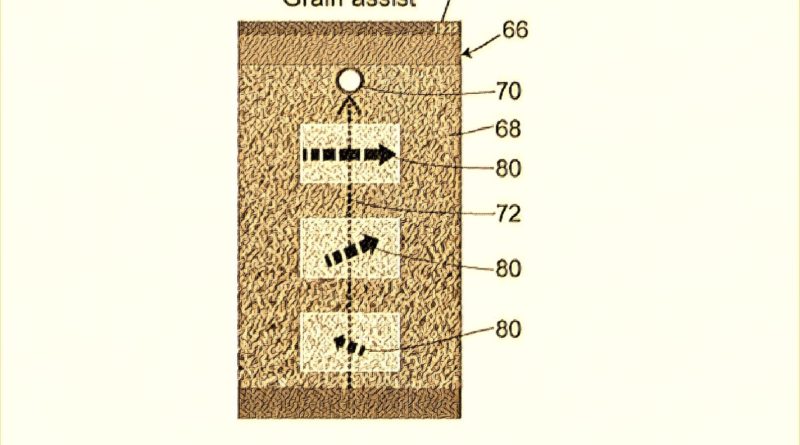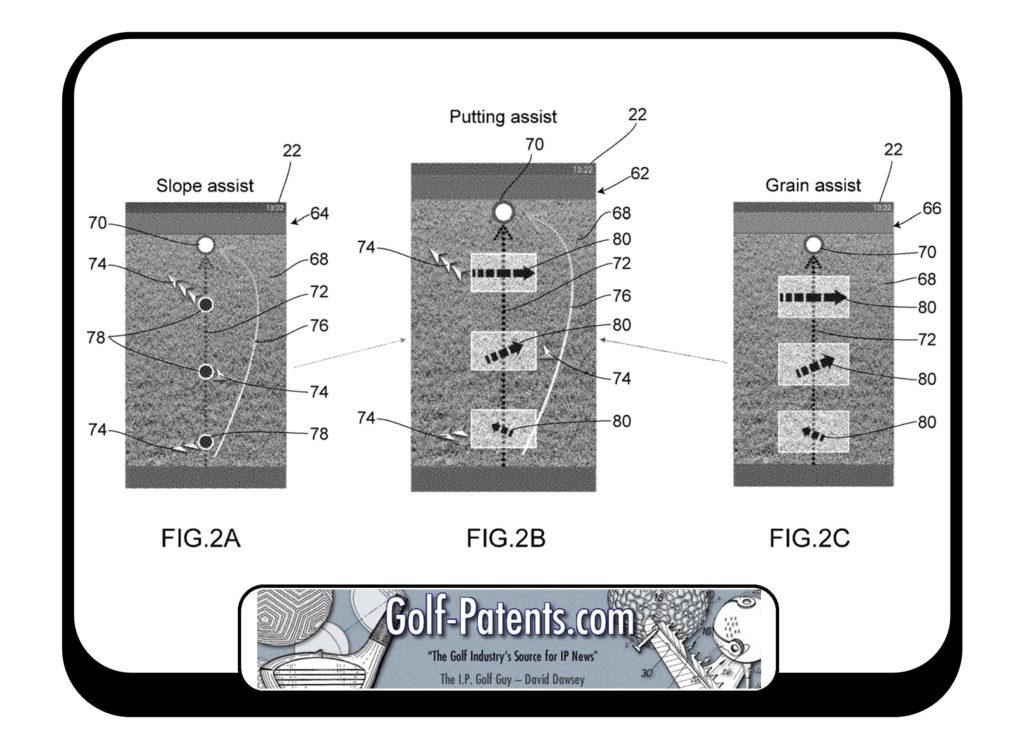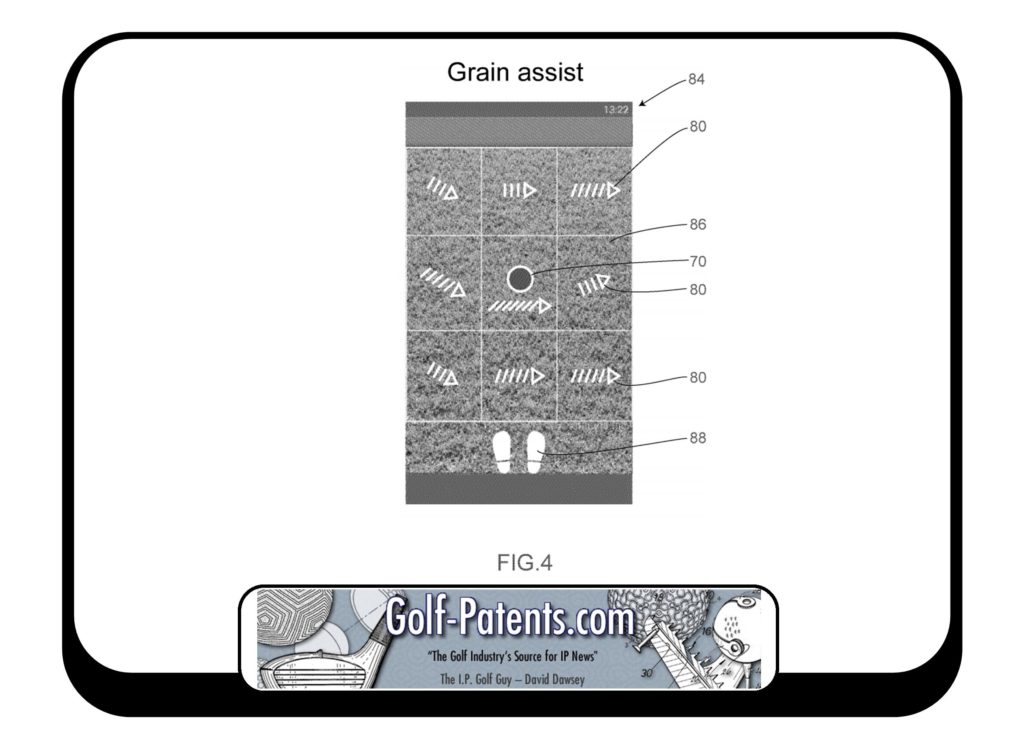A Golf App That I Could Actually See Myself Using
Most golf apps are a dime a dozen; you use them religiously for about a month and then they are never opened again. Well, this month a patent issued disclosing a golf app that I could see myself using for at least twice the typical honeymoon period, especially when traveling to courses with greens having grass that is different from my home course. See what you think.
The patent is USPN 10,096,260 titled “Golf Play Assisting System,” which describes the invention as:
Provided is a golf play assisting system enabling players to get an intuitive picture of the condition of the grain. When an image of a portion of a turf target is taken by a player to study the grain of the target turf by using an image-taking device of a mobile terminal, an image processing and analyzing unit performs image processing and image analysis against original image data captured thereby. As a result, symbolized images of the grain data, indicating a direction and inclination of the grain at each specific location in the turf target, are then displayed on a display unit of the mobile terminal on top of a processed image data visibly highlighting the grain of the target turf.
The patent goes on to explain:
The image processing and analyzing unit 56 is configured not only to recognize a turf section in the original image, taken by the image-taking unit 18, and perform an image processing in order to produce processed image data visibly highlighting the grain, but also to obtain grain data, through image analysis of the turf section, indicating directions and/or inclinations of the grain at specific locations in the turf section, and store these processed image data and grain data in the third memory section 40.
Here, the term “specific locations” refers to a plurality of measuring target points located by the position locating unit 50, or correspond to a plurality of turf regions located around the nearest cup location, including at least any regions or points in a turf section whose original image data are capable of being analyzed.
The image processing and analyzing unit 56 generates the above-described processed image data by performing image processing for: contour enhancement; gray scale level adjustment; and/or contrast adjustment, against the original image data retrieved from the image-taking unit 18. The contour enhancement refers to a processing of detecting data, among original image data, with respect to a contour of the turf that is image-taken, to enhance the contour of the turf. The gray scale level/contrast adjustment refers to a processing of adjusting the gray scale level/contrast thereof. There may be contained in the image processing and analyzing unit 56 any other image processing functions capable of highlighting the condition of the grain in an easy-to-read manner.
The putting assist information generating unit 58 is configured to use not only turf slope information and acceleration information that are retrieved from the second memory section 38, and/or grain data retrieved from the third memory section 40, but also information regarding green speed and compaction contained in the green-related data that are stored in the fourth memory section 42. The putting assist information generating unit 58 utilizes the above-described information to estimate, as putting assist information, a trajectory of a ball to be rolled toward the nearest cup location from the measurement starting point when putted from the measurement starting point by the putter with which the assistive tool 32 is hit.
The display controller 60 is configured to symbolize grain data, retrieved at least from the third memory section 40, and display, on the display unit 22 in the display mode 10, the symbolized grain data, indicating directions and inclinations of the grain at specific locations, on top of the processed image at the specific locations highlighting grain whose image data are retrieved from the third memory section 40. The display controller 60 described herein also serves not only to symbolize the above-described grain data but also to symbolize the turf slope information retrieved from the second memory section 38 in order to display the symbolized turf slope information at the specific locations on top of the image indicating the processed image data.
In the present embodiment, in response to an operation signal from the operating unit 20 for changing a display mode, the display controller 60 switches the display mode of the display unit 22 to either one of: a general mode as a first mode displaying, on the image of the processed image data, both the symbolized grain data and the grain slope information; and a professional mode, as a second mode, displaying the symbolized grain data alone in such a manner as being superimposed on the image of the processed image data. Note that this display mode shall not be limited only to the above-described modes. That is, there may be employed, e.g., a single mode display mode only one of the first and second modes, or a display mode having a further mode in addition to the first and second modes.
FIGS. 2A, 2B, and 2C illustrate display modes where images of so-called “putting assist” mode, corresponding to the above-described general mode, are displayed on the display unit 20 by the display controller 60. Numeral 62 shown in FIG. 2B denotes a screen image of the “putting assist” mode, which is shown on the display unit 22. In this mode, a screen image 64 of so-called “slope assist” mode, as shown in FIG. 2A and a screen image 66 of so-called “grain assist” mode, as shown in FIG. 2C, where both of these modes are in general mode, are functionally combined with each other in order to establish an advanced mode.
As shown in each of the screen images 62, 64, and 66, as illustrated respectively in FIGS. 2A, 2B, and 2C, numeral 68 denotes a display portion of the processed image, or processed image background visibly highlighting the grain. The processed image background 68 is displayed all over the display area on display unit 22. Numeral 70 denotes a cup location indicator, which is denoted by a white circle as the nearest cup location on the processed image background 68. Numeral 72 denotes a first arrow indicator which is denoted by a line with an arrowhead, showing the direction of a straight path extending from the measurement starting point to the nearest cup location.
.
.
.
Next, a display mode for the “grain assist” mode, indicating a professional mode, will be described in great detail with reference to FIG. 4. FIG. 4 illustrates, on the display unit 22, a screen image 84 of so-called “grain assist” mode where a black circle indicates a cup location indicator 70 indicating the nearest cup location around which segmentation indicators 86 are arranged, on top of the processed image background 68, on a turf surface where the segmentation indicators 86 are made up of a combination of straight lines delimiting a plurality of segments (nine segments as for the display mode shown in FIG. 4.) Here, as with the screen image 62 in the “putting assist” mode, in each of the turf segment is arranged the second slope indicator 80 that is denoted by a triangular arrowhead and a plurality of bars arranged in parallel with each other, representing a symbolized image of grain data. Also, numeral 88 denotes a standing position indicator virtually representing a standing location of the player.
The “grain assist” display mode, as shown in the screen image 84, is a professional mode; that is, there will not be indicated any first slope indicator 74, indicating turf slope information thereof, or ball trajectory indicator 76, indicating a trajectory of the ball to be rolled, where both of the indicators are hidden from the screen unlike the general mode. Instead, there will be indicated, as the second slope indicator 80, symbolized images of grain data at each of the segments in the vicinity centering around the nearest cup location around which the player has an intention to play. Here, in each of the segments, players can instantly recognize that the larger the number of bars becomes and the more steeply the bars get inclined with respect to the direction of an arrow, then it indicates the grain more steeply inclined in the direction of the arrow, and that the fewer the number of bars becomes and more perpendicularly the bars are arranged with respect to the direction of an arrow, then it indicates the grain more mildly inclined in the direction of the arrow.
.
.
.
In Step 13 as illustrated in FIG. 4, on top of the processed image background 68, highlighting the grain thereof as compared to the original image data, are shown: the cup location indicator 70, indicating the nearest cup location; the second slope indicator, indicating grain data at each of the turf segments, which is obtained through image analysis of the original image data that are input from the image-taking unit 18; the segmentation indicators 86 delimiting the position of each turf segments; and the standing position indicator 88 virtually indicating a standing location of the player.
With the above descried steps, the screen image 84 in a professional “grain assist” mode will be shown on the display unit 22, allowing players to get an intuitive picture of a direction/inclination of the grain at each of the turf segments with a help of a displayed image of the second slope indicator 80, and players are further allowed to recognize the condition of the grain not only in the measuring target points but also in any other place in the turf, with a help of the processed image background 68 as shown in the background.
As an alternative display mode for the screen image 84 in the “grain assist” mode as shown in FIG. 4, the second slope indicator 80 may be indicated in a color variable in accordance with a degree at which the grain is inclined. Furthermore, there may be employed various icons for display modes of the second slope indicator 80, without in any way being limited to those shown in FIG. 4.
Sounds good. Now, for all the patent attorneys out there, here is the first independent claim:
1. A golf play assisting system using a mobile terminal equipped with an image-taking device and a display unit, comprising:
an image processing and analyzing unit that retrieves an original image data of a target turf from the image-taking device; allows an image of the target turf contained in the original image data to go through image processing and image analysis to obtain processed image data of the target turf visibly highlighting a grain of the target turf; and
obtains grain data indicating directions and inclinations of the grain at two or more specific locations on the target turf in the original image taken by the image-taking device;
a display controller superimposing the grain data on the processed image data with the grain data being symbolized and then displaying a resultant image data on the display unit of the mobile terminal; and
a position locating unit that locates:
a measurement starting point corresponding to a point where the original image was taken by the mobile terminal;
a nearest cup location as located nearest to said measurement starting point among a plurality of cups; and
two or more measuring target points located along a straight line extending from said measurement starting point to said nearest cup location, through a positioning data obtained from a location detector incorporated in the mobile terminal upon retrieval of the original image data from the image-taking device, wherein said image processing and analyzing unit is configured to obtain the grain data at each of the measuring target points located by the position-locating unit as said specific locations.
The patent owner is Techno Craft Corp Ltd and the app seems to be free, but the comments regarding privacy were enough to keep me from downloading it. Let me know if you have used it, and if it is helpful (I might be willing to sacrifice privacy for 2 strokes a round)!
Dave Dawsey – An Ohio Patent Lawyer
PS – please follow me on Twitter (@GolfPatents), and heck – connect with me on LinkedIn.
PPS – If you like what we are doing, please considering helping us out and make your online gear purchases through our Amazon affiliate link. Every little purchase helps us keep the site up and running! Thanks.



